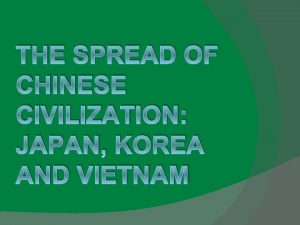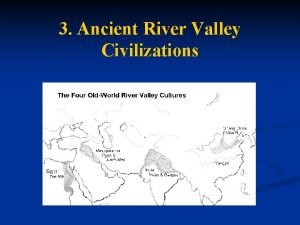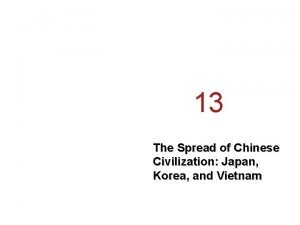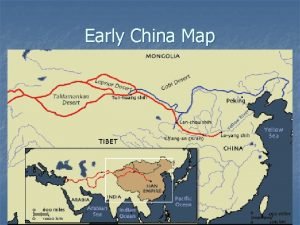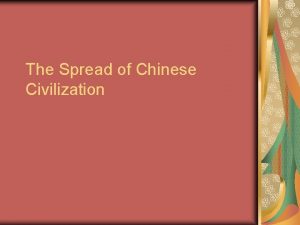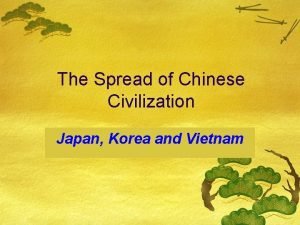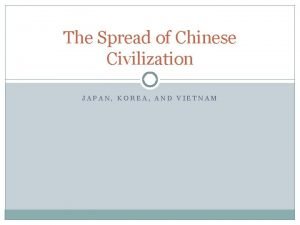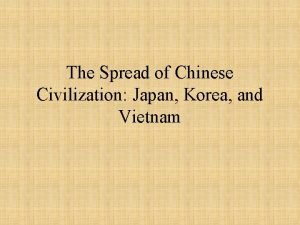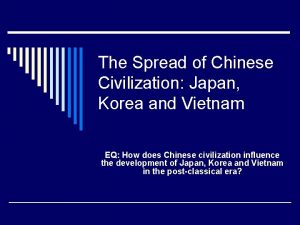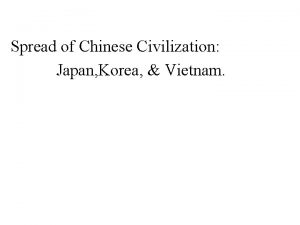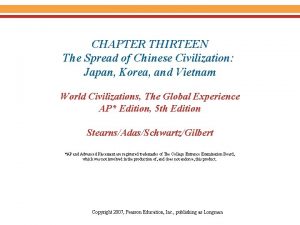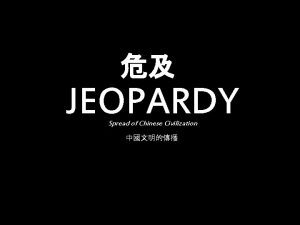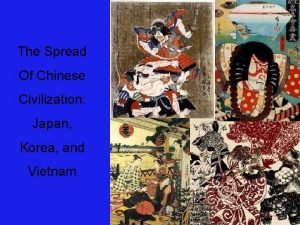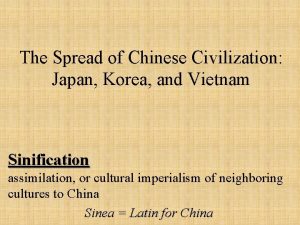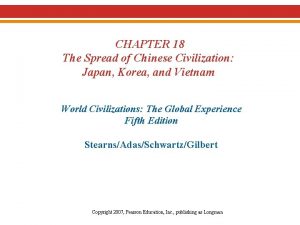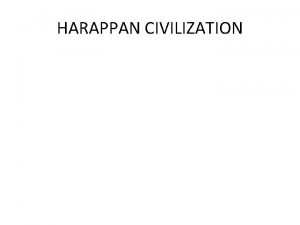CH 13 The Spread of Chinese Civilization Japan





































- Slides: 37

CH 13 The Spread of Chinese Civilization Japan, Korea and Vietnam

“sinicization” £In general contexts, Sinicization refers to the process of "becoming Chinese"

Borrowing from the neighbors £Japan has always looked to China as an influence £During 7 th to 9 th centuries this was intense £Taika reforms tried to make Japanese government more like China

£Intellectuals and aristocrats absorbed Chinese culture £The common people looked to Buddhism for comfort £The Taika reforms were resisted by the aristocracy £After a takeover attempt the Taika reforms were abandoned, local lords started their own armies

The Heian Era- Court Life £A new capital was started at Kyoto £There were strict rules for life £Poetry flourished, Chinese script was modified £Women were very involved in court life

Lady Murasaki The Tale of Genji £This was the first novel published anywhere, it is a story of love and intrigue in the Imperial court

The Decline of Imperial Power £Aristocratic families began to take more and more control £Fujiwara family came to dominate £Peasants and artisans lost even more power

The Warrior Elite £Warrior leaders (BUSHI) governed and taxed their lands for themselves, not the court £They created their own armies. SAMURAI “one who serves”










£By 11 th century samurai were widespread £The warrior code valued honor and courage above all £Seppuku (ritual suicide) was considered the way to maintain honor in defeat

£Peasants lost even more power £They became serfs £They could not move up in class £Many looked to pure land Buddhism for comfort

Declining influence of China £By 838 the Japanese cut ties with Tang China £The Gempei wars caused great suffering £The Minamoto emerged victorious £Military govt. (Bakufu) established at Kamakura £Japan became a feudal state

£After the Minamoto the Hojo family came to power (Shogun) £The emperor and Minamoto became puppet rulers £Civil wars followed for 10 years £Japan broke into 300 competing states run by warlords (Daimyos)

TOMOE GOZEN


Comparing Japanese and European Feudalism £Both rose due to weak central governments. £Both were based on mutual obligations and military needs £There were differences- In Japan family and social bonds were very strong £Losing in battle was the worst disgrace

Military divisions/ Social Change £ 15 th and 16 th century Warfare became deadlier and constant £Daimyos gained more power, the economy grew. £A new class of wealthy merchants emerged. £Women lost almost all power with rare exceptions

KOREA

Korea £The Tang ruled Korea till 668, remained independent till early 20 th century £During Silla alliance period China had its greatest influence £Art, learning and manufacture were borrowed

£Some Koreans studies for Confucian exams, but most jobs were determined by family connections £Most of Korean society was dominated by a small aristocratic elite £All groups below them served them - ‘low born’ virtual slaves

Periodic revolts £The burdens on the commoners caused periodic revolts £A century of conflict till YI dynasty established in 1392 £Maintained ties with China £It lasted till 1910

SOUTHEAST ASIA VIETNAM

Southeast Asia - Vietnam £China pushed south into their territory £Viet people resisted the Chinese, they had a strong culture and were far from the Chinese center £They took what they wanted from Chinese culture

£The Han dynasty demanded tribute, later they conquered and ruled directly £Viets were sent to school in China £There were some revolts, peasants never wanted Chinese control £Trung sisters led a revolt in 39 C. E.

£"All the male heroes bowed their heads in submission; Only the two sisters proudly stood up to avenge the country. " 15 th century Poem

£The great distance from China helped £By 939 Korea was independent £Local scholar gentry never had the same power as in China £Locals Viet officials favored the peasants and village rulers instead of the ruling dynasty

Struggle for Control £Two main powers £Trihn- centered in Hanoi £Nguyen- centered in Hue £Fought for 200 years

Summary £Japan, Korea and Vietnam were influenced most because they had large farming centers £Writing, bureaucracy, religion, art were all influenced China £Each culture was mixed in how much they borrowed

£Korea- political submission and cultural dependence £Vietnam- conquest and control for a 1000 years £Japan escaped direct rule, but Japan adopted many aspects of Chinese arts and government, then modified them
 Spread of china's literature to heian japan and korea
Spread of china's literature to heian japan and korea 4 river valley civilizations
4 river valley civilizations Bushi
Bushi Chinese civilization map
Chinese civilization map Anglo chinese primary
Anglo chinese primary Các môn thể thao bắt đầu bằng từ đua
Các môn thể thao bắt đầu bằng từ đua Tư thế ngồi viết
Tư thế ngồi viết Cái miệng bé xinh thế chỉ nói điều hay thôi
Cái miệng bé xinh thế chỉ nói điều hay thôi Hình ảnh bộ gõ cơ thể búng tay
Hình ảnh bộ gõ cơ thể búng tay Cách giải mật thư tọa độ
Cách giải mật thư tọa độ Tư thế ngồi viết
Tư thế ngồi viết Thế nào là giọng cùng tên?
Thế nào là giọng cùng tên? Voi kéo gỗ như thế nào
Voi kéo gỗ như thế nào Thẻ vin
Thẻ vin Thể thơ truyền thống
Thể thơ truyền thống Hổ sinh sản vào mùa nào
Hổ sinh sản vào mùa nào Từ ngữ thể hiện lòng nhân hậu
Từ ngữ thể hiện lòng nhân hậu Thế nào là hệ số cao nhất
Thế nào là hệ số cao nhất Diễn thế sinh thái là
Diễn thế sinh thái là Lp html
Lp html Vẽ hình chiếu vuông góc của vật thể sau
Vẽ hình chiếu vuông góc của vật thể sau 101012 bằng
101012 bằng Lời thề hippocrates
Lời thề hippocrates Vẽ hình chiếu đứng bằng cạnh của vật thể
Vẽ hình chiếu đứng bằng cạnh của vật thể Tư thế worm breton là gì
Tư thế worm breton là gì đại từ thay thế
đại từ thay thế Quá trình desamine hóa có thể tạo ra
Quá trình desamine hóa có thể tạo ra Công thức tính thế năng
Công thức tính thế năng Khi nào hổ con có thể sống độc lập
Khi nào hổ con có thể sống độc lập Thế nào là mạng điện lắp đặt kiểu nổi
Thế nào là mạng điện lắp đặt kiểu nổi Các châu lục và đại dương trên thế giới
Các châu lục và đại dương trên thế giới Dạng đột biến một nhiễm là
Dạng đột biến một nhiễm là Bổ thể
Bổ thể Biện pháp chống mỏi cơ
Biện pháp chống mỏi cơ Phản ứng thế ankan
Phản ứng thế ankan Thiếu nhi thế giới liên hoan
Thiếu nhi thế giới liên hoan Chúa yêu trần thế
Chúa yêu trần thế điện thế nghỉ
điện thế nghỉ
